Dynamical Analysis of a Delay Two-Prey–One-Predator Model Incorporating Fear Effect in the Growth Rate of Preys
Abstract
In an ecological point of view, fears from predator cause physiological changes of prey population and these physiological changes may reduce the reproduction of prey. This paper deals with studying the effect of fear that is incorporated in the growth rate of prey on the dynamics of a delay ecological model consisting of two logistically growing prey species, namely, preyXand preyY, and a predator species. The predators take energy and biomass on predating on prey X as well as prey Y with extended Holling Type II functional response. We conduct a thorough analytical examination of the system, demonstrating the positivity and boundedness of the solutions. Criteria for the persistence of the model are founded. Seven biologically possible steady states are determined, and the local dynamics around the steady states based on the parameters are also investigated. Next, we investigated the occurrence of Hopf bifurcation around the prey X– and Y–free steady state, by taking the value of the time delay as a bifurcation parameter. Finally, we perform extensive numerical simulations to support the evidence of our analytical results and reveal the occurrence of Hopf bifurcation within the proposed model.
1. Introduction
In the recent years, the dynamic interaction between predators and their prey has been modeled by both a mathematician and biologist author [1–5]. In ecology, average number of eaten preys by one predator in a unit time is called functional response. Therefore, functional response is the important element to represent the dynamic relationship between predator population and prey population [6]. There are many types of functional response; among them is Holling Type II functional response which is characterized by decelerating intake rate [7, 8]. In nature, many predator species predate multiple species of prey. For example, lions usually predate many species of prey such as antelopes, buffaloes, crocodiles, giraffes, pigs, zebra, wild dogs, and wildebeest. Therefore, some mathematician authors investigate mathematical modeling for the dynamic interaction between one predator and multiple preys [3, 6]. Elettreby in [3] discussed the global stability and persistence of a one-predator and two-prey model. Fatah, Mustafa, and Shilan in [6] extended the Holling Type II functional response for n-preys. Population dynamics may be affected by many factors of natural environment like fear, harvesting, toxicity, stage structure, delay, cannibalism, antipredator skills, refuge, infectious illness, and other population-affecting elements [9–12].
Predation fears from predator causes physiological changes of prey population, and these physiological changes may reduce the reproduction of prey population [13]. Wang, Zanette, and Zou [14] considered a predator–prey model incorporating fear effect on reproduction of prey individuals; in their study, they noticed that the fear has no impact on the stability of the model when the system incorporates bilinear functional response, but the system becomes stable under fear effect, if it incorporates the Holling Type II functional response; based on their system, Pal et al. [15] considered a prey predator with fear effect and harvesting cooperation; they discussed the stability, Hopf bifurcation and Bogdanov–Takens bifurcation the system. Zhang et al. [16] considered an ecological model with fear effect and prey refuge; they showed that the effect of both factors can stabilize the system. For more results about fear effect, see [9, 17–20].
In predator–prey models, time delay on prey is the period of time between the prey predation and predator response to the predation. Haque et al. [21] investigated the effect of delay in a Lotka–Volterra-type predator–prey model with a transmissible disease in the predator species. Liu et al. [20] studied the dynamics of a predator–prey model with the effect of both fear and time delay. Abbas and Naji [22] considered and studied a food web model including two competing predator species and one prey species with Monod–Haldane functional response. For more results about time delay, see [23–26].
Based on the Lotka–Volterra-type predator–prey model, in the current work, we consider a two-prey–one-predator model incorporating the effect of fear in the growth rate of prey species and time delay between the prey predation and predator response to the predation. In Section 2, the details of the model formulation are given and some properties of the model’s solution are derived. In Section 3, the existence conditions of all feasible steady states are found. In Section 4, local stability analysis of the model and Hopf bifurcation near steady states are studied. In Section 5, discovering the impact of fear and time delay and illustrating the analytical finding that observed in this work are done through preforming some numerical simulations. Finally, in Section 6, a brief conclusion on the total work is given.
The novelty of this paper is discovering the effect of fear in prey and time delay between the prey predation and predator response to the predation on the dynamics of an ecological model including two different prey species and one predator species and the model incorporating the Holling Type II functional response which is modified by authors in [6].
2. The Mathematical Model and Its Solution Properties
- i.
The number of prey X and prey Y and predator at instant time t is denoted by X(t), Y(t) and P(t), respectively.
- ii.
Both species of prey X and prey Y grow logistically with intrinsic growth rate r1 and carrying capacity K1 for prey X and intrinsic growth rate r2 and carrying capacity K2 for prey Y.
- iii.
The effect of fear is incorporated in the intrinsic growth rate of prey population due to the predator [27]. The intrinsic growth rates of prey X and prey Y are decreased, and they multiplied by 1/(1 + f1P) and 1/(1 + f2P), respectively, where f1 and f2 are levels of fear due to prey X and prey Y response to antipredators, respectively.
- iv.
Prey X and prey Y are killed directly by predator species according to extended Holling Type II functional response α1P/(1 + α1T1X + α2T2Y) and α2P/(1 + α1T1X + α2T2Y), respectively, where α1 and α2 are the predator’s search efficiency for prey X and prey Y, respectively, and T1 and T2 are the predator’s average handling times of prey X and prey Y, respectively.
- v.
The period between the prey predation and predator response to the predation is denoted by τ.
- vi.
The predator number decreased by natural death with rate d and intraspecific competition between individuals of predators with rate c.
- vii.
The biomass of prey X and prey Y is converted to the biomass of predator with rates e1 and e1, respectively.
Functions F, G, and H in System (1) are continuous and has partial derivatives on the space R3, and hence, System (1) satisfies the Lipschitzian condition. Therefore, by uniqueness theorem, it has unique solution. Further, the time derivative of X, Y, and Z are zero in YZ‑plane, XZ‑plane, and XY‑plane, respectively. Therefore, if the solution initiates at a nonnegative point, then the components X, Y, and Z of the solution points of System (1) cannot cross any coordinates of the solution points. Hence, components X, Y, and Z of solution points are always nonnegative. Further, some properties of solutions of System (1) are proved in the following lemma and theorems.
Lemma 1. In System (1), the following inequalities are satisfied:
- a.
, , and .
- b.
If Re < 1, then , , and .
- c.
If XMin > 0, then .
- d.
If Ymin > 0, then .
- e.
If PMin1 > 0, then .
- f.
If PMin2 > 0, then .
- g.
If XMin > 0, YMin > 0, and PMin1 > 0, then .
Proof 2 (b). By applying Part (a) in the third equation of System (1), it also gets
If Re < 1, then , and hence, System (1) can be reduced to the following equations:
Solving above equations it gets and .
Proof 4 (d). Applying Part (b) in the second equation of System (1), it gets
Therefore, if Ymin > 0, then .
Proof 5 (e, f, and g). Applying Part (c) and Part (d) in the third equation of System (1), the following inequalities are obtained:
So,
The proof is completed.
From Lemma 1 (a), the following theorem can be derived.
Theorem 1. All solutions of System (1) are bounded.
Also, from Lemma 1 (c–g), the following theorem can be derived.
Theorem 2. If PMin1 > 0 and PMin2 > 0, then System (1) persists.
3. Existence of Steady States
- 1.
Extinct steady state S1(0, 0, 0)
- 2.
The axial steady state S2(K1, 0, 0)
- 3.
The axial steady state S3(0, K2, 0)
- 4.
Predator-free steady state S4(K1, K2, 0)
Clearly, H1(K1) < 0, so there is a root of H1(X) in ]XMin, K1[.
- 5.
Prey X–free steady state S6(0, Y6, P6), where
Clearly, H2(K2) < 0, so there is a root of H1(X) in ]YMin, K2[.
- 6.
Coexistence steady state S7(X7, Y7, P7)
Therefore, S7(X7, Y7, P7) exists if System (4) has positives solution.
4. Local Stability and Hopf Bifurcation
The eigenvalues of variational matrix at S2(K1, 0, 0) are r1 > 0, r2 > 0, and −d.
The eigenvalues of variational matrix at S2(K1, 0, 0) are −r1 < 0, r2 > 0, and (e1α1K1/(1 + α1T1K1)1 + α1T1K1) − d.
The eigenvalues of variational matrix at S3(0, K2, 0) are r1 > 0, −r2 < 0, and (e2α2K2/(1 + α2T2K2)1 + α2T2K2) − d.
Therefore, S1(0, 0, 0), S2(K1, 0, 0), and S3(0, K2, 0) are saddle points.
The eigenvalues of variational matrix at S4(K1, K2, 0) are −r1 < 0, −r2 < 0, and (1/d)(Re − 1).
Thus, S4(K1, K2, 0) is LAS, if and only if Re < 1.
Theorem 3. For 0≤τ < (1/y0)sin−1(A1y0/C1), S5(X5, 0, P5) is LAS, if the following conditions hold:
Further, in addition to Conditions (5) and (6), if the following conditions hold
Proof 6. The characteristic equation at S5(X5, 0, P5) is
One of the eigenvalues is γ1 = (r2/(1 + f2P5)1 + f2P5) − (α2P5/(1 + α1T1X5)1 + α1T1X5) < 0 due to Condition (5) and other eigenvalues of the satisfy the following equation:
Under Condition (6), the roots of Equation (6) are neither zero nor positive; therefore, the eigenvalues are negative or complex. Note that at τ = 0, condition guarantees that all eigenvalues have negative real part. Let τ ≠ 0,; λ(τ) = x(τ) + iy(τ) is the root of the Equation (9), and is least positive number such that .
Then,
Puttingin the above two equations, then adding and squaring them, the following equation is obtained:
It is obvious that under Condition (7), Equation (11) always has one positive root, say y0.
From Equation (11), it gets
Further, suppose ; then, from Equations (10) and (11), it gets
,which is impossible; therefore, .
In a similar way of proving Theorem 3, the following theorem can be derived.
Theorem 4. If the following conditions hold, then, for 0≤τ < (1/y0)sin−1(A1y0/C1), S6(0, Y6, P6) is LAS.
Further, in addition to Conditions (13) and (14), if the following conditions hold
with
Theorem 5. If S7(X7, Y7, P7) exist, then it is LAS if the following conditions hold:
Proof 7. The linearized system around S7(X7, Y7, P7) can be written as
Consider the function Q(U, V, W) = L1(U, V, W) + L2(U, V, W) where L1(U, V, W) = (1/2)U2 + (1/2)V2 + (1/2)W2 and .
It is clear that L1(U, V, W) is positive and L2(U, V, W) = 0, if and only if (U, V, W) = (0, 0, 0, ).
Under conditions (17)–(20), dL/dt is negative. and hence, , and this completes the proof.
5. The Ecological Basic Reproduction Number
As expected, when the predator’s death rate assumes high values, the predator’s biomass decreases, which can lead to the collapse of the ecosystem since predators are important to establishing the balance of nature in the ecosystem. It is crucial to determine the parameters which have impact on predator’s biomass, and this helps to make procedures to prevent a decrease in the predator’s biomass. Therefore, in this section, we discuss a threshold parameter which is known as the ecological basic reproduction number, and it may be thought about as the number of predator (one predator) gives rise to during its life [6]. The usual situation is that, if the ecological basic reproduction number is less than one, the predator-free stead state is LAS. This means that the predator’s biomass decreases and dies out gradually [6].
In Lemma 1 (b), it is proved that if, Re < 1, then , , and .
Note that Re is independent on level fear and time delay, so both factors have no impact on the l stability of predator-free steady state. Further, in the next section, we will confirm that the factors of level fear and time delay do not affect the dynamical behavior near the predator-free steady state.
6. Numerical Simulation
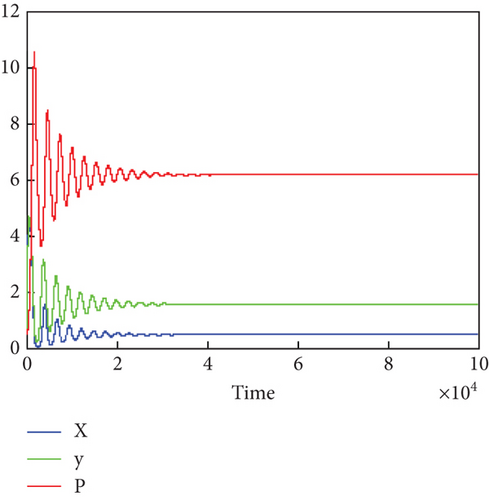
When we increase the value of f1 to 0.3 and fix other parameter values as given in (21), the trajectories of System (1) approach the prey X–free steady state, as shown in Figure 2.
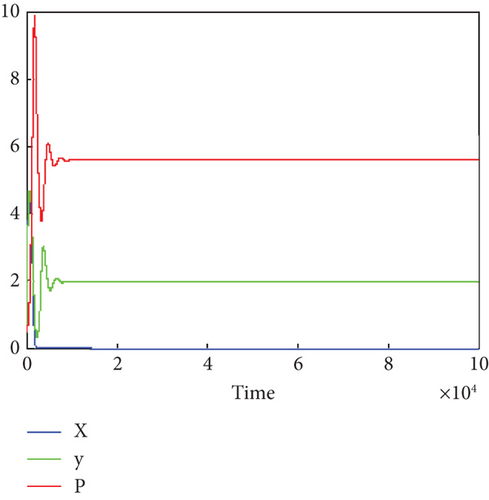
Now, let us increase the value of f2 to 0.4, and fix other parameter values as given in (21); the trajectories of System (1) approach the prey Y–free steady state, and this is illustrated in Figure 3.
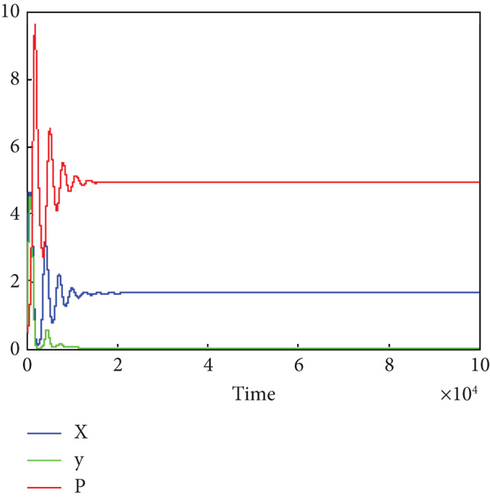
Note that the parameter values used to draw Figures 2 and 3 satisfy the criteria for stability conditions for prey X–free steady state and prey Y–free steady state S5, respectively, and this confirms the analytical result regarding stability of S5 and S6.
From Figure 1, it is observed that for a small value of fear level, the coexistence of all the populations is guaranteed.
From Figures 2 and 3, it is observed that for a larger value of fear level, no longer in existence of prey species may happen.
According to time delay, the long-term behavior for a range of value of time delay is plotted in the following bifurcation diagrams, where the x-axis is the range of time delay and the y-axis is limit sets of populations.
In Figure 4, System (1) is solved with τ ∈ [1.5, 3.5 ] and the parameter values are fixed as given in (21). The figure indicates the emergence of Hopf bifurcations near S7 as, parameter τ passes through .
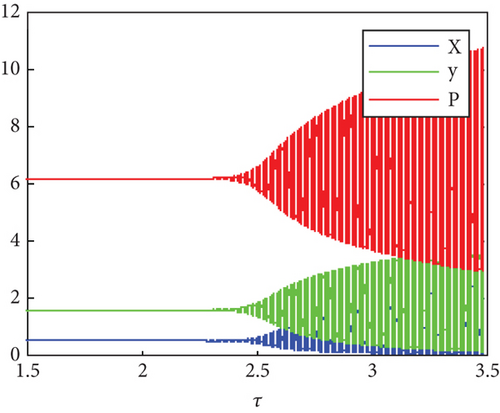
In Figure 5, System (1) is solved with τ ∈ [5.5, 7.5 ] and f1 = 0.3 and fixed other parameter values as given in (21); the figure indicates the emergence of Hopf bifurcations near S6 as τ passes through .
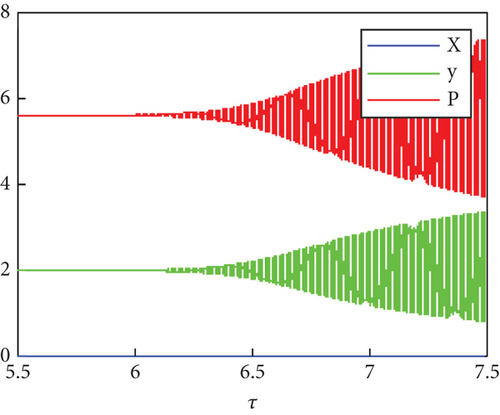
In Figure 6, System (1) is solved with τ ∈ [5.5, 7.5 ] and f1 = 0.4 and fixed other parameter values as given in (21); the figure indicates the emergence of Hopf bifurcations near S5 as τ passes through τ ≈ 4.3.

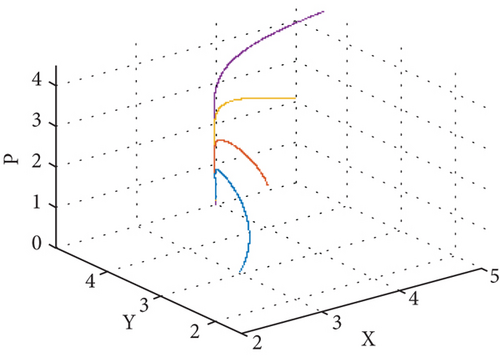
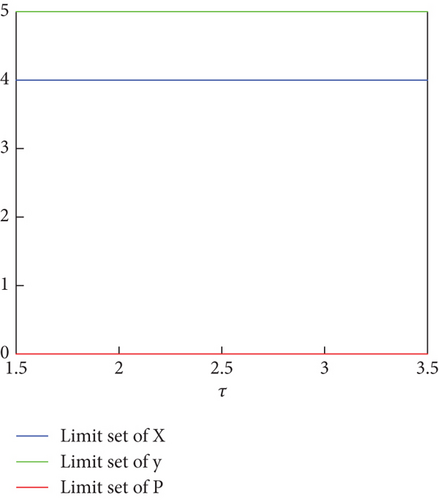
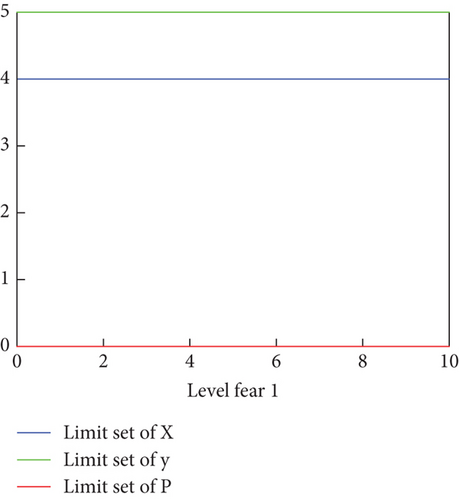
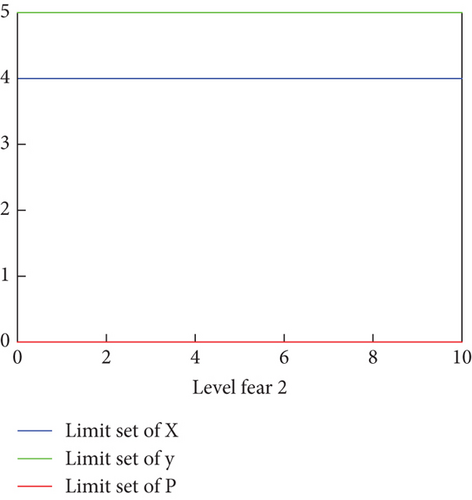
Note that when we vary the value of fear effect and time delay, the value Re does not change and dynamics near the predator free steady state does not affect and this is illustrated in Figures 7(b) and 7(c). This confirms the analytical result regarding the ecological reproduction number.
7. Conclusion and Discussion
Fears from predators may reduce the reproduction of prey population, and the period of time between the prey predation and predator response to the predation plays a vital role in population. In this paper, the dynamic interaction between two prey species and one predator species under the consideration of the fear effect on both prey species and time delay corresponding to the gestation period is modeled through a set of differential equations. It is explored that System (1) has at most seven steady states; they are denoted by Si, i = 1, 2, 3, 4, 5, 6,7; it is proved that S1, S2, and S3 are unstable while the criteria for the LAS of the other steady state are determined. The bifurcating values of time delay for occurrence of Hopf bifurcation in System (1) near the prey X–free and prey Y–free steady states are given in Theorem 3 and Theorem 4, respectively. Therefore in Theorems 3 and 4, we can implicate that if the value of time delay is changed, System (1) may induce a transition from the stability situation to the state where the populations oscillate periodically and numerically; this implication is illustrated in Figures 4, 5, and 6. In Figures 1, 2, and 3, we observed that for small value of fear level, the coexistence of all the populations is guaranteed but for larger value of fear level, no longer in existence of prey species may happen. The ecological reproduction Re for System (1) is also found. It is noted that Re is independent on the fear level and time delay. By numerical simulation, we have shown that Re is not affected by change in the value of fear level or time delay as shown in Figure 7. Those analytical and numerical results regarding Re confirm that the locally stabilization at predator-free steady state is independent of the factors of both fear and time delay.
Conflicts of Interest
The authors declare no conflicts of interest.
Author Contributions
We confirm that the manuscript has been read and approved by all named authors and that there are no other persons who satisfied the criteria for authorship but are not listed. We further confirm that the order of authors listed in the manuscript has been approved by all of us.
Funding
We confirm that the manuscript received no external funding.
Open Research
Data Availability Statement
We confirm the data that support the findings of the manuscript are available on request from the corresponding author.




